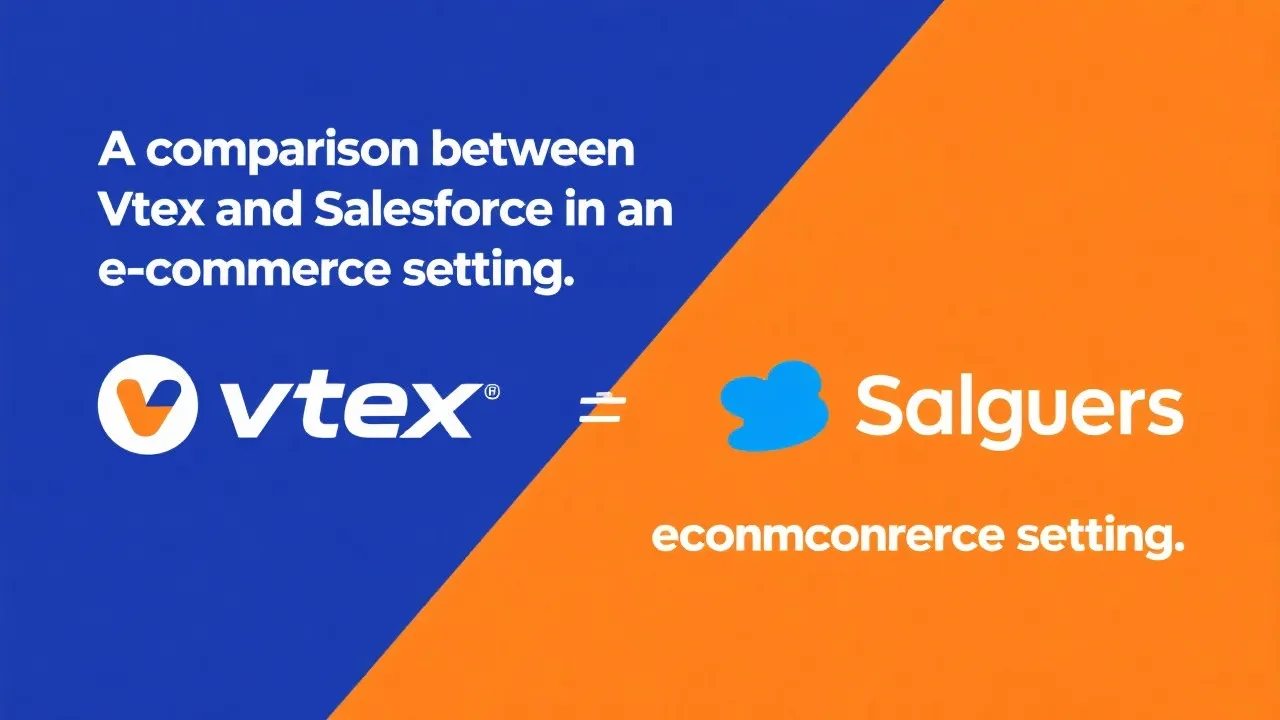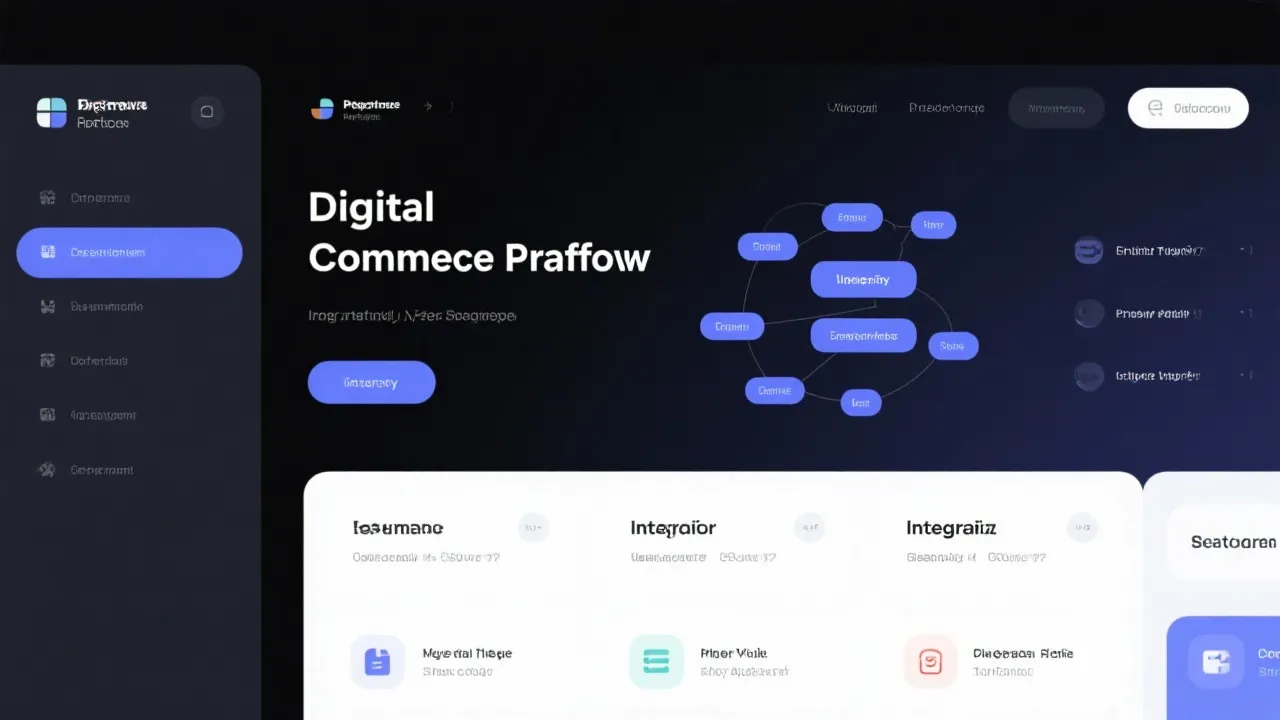Comparing Vtex and Salesforce Solutions
This article explores the distinct features and advantages of Vtex and Salesforce, two leading platforms in the e-commerce industry. Vtex offers an integrated commerce solution with robust features for seamless management, while Salesforce provides a highly customizable framework with strong CRM capabilities. Both serve unique business needs, offering diverse solutions for online marketplaces.

Introduction to E-Commerce Platforms
In the rapidly transforming world of e-commerce, choosing the right platform is crucial for business success. The two industry leaders that often dominate this conversation are Vtex and Salesforce. Each offers unique advantages tailored to specific business requirements. With e-commerce continuing to evolve, understanding the intricacies of these platforms can make a significant difference in operational efficiency, customer satisfaction, and ultimately, profitability.
Overview of Vtex and Salesforce
Vtex is a recognized name in the e-commerce domain, providing a comprehensive platform that integrates commerce, marketplace, and order management in a single solution. Known for its flexibility and efficient management capabilities, Vtex enables businesses to scale rapidly and efficiently, addressing the needs of both B2B and B2C enterprises. Its cloud-based infrastructure facilitates seamless updates and ensures users stay aligned with the latest technological advancements.
Salesforce, on the other hand, is primarily known for its market-leading Customer Relationship Management (CRM) solutions. It offers powerful tools for managing customer relationships and sales data. In addition to its core CRM services, Salesforce has expanded into the e-commerce field, leveraging its robust framework to provide custom solutions that enhance customer engagement and streamline business processes. Salesforce Commerce Cloud, a significant offering in its suite, combines the best of both worlds by integrating powerful customer service support with e-commerce functionalities.
Key Features of Vtex
- Integrated Solution: Vtex combines the functionalities of an e-commerce platform, marketplace, and order management system, enabling seamless operations. This integration facilitates quicker transaction times, better inventory management, and overall enhanced customer experience.
- Scalability: As businesses grow, Vtex scales easily to meet increased demands. Its elastic architecture allows businesses to handle sudden spikes in traffic, particularly during high-demand seasons such as holidays or promotional events.
- Omnichannel Capability: It provides an omnichannel experience, ensuring consistency across multiple customer touchpoints. This means customers can switch from web to mobile app, and to physical stores without losing their shopping context, which significantly boosts user satisfaction.
- CMS and Development Tools: Vtex offers a robust content management system and development tools tailored for innovation in e-commerce. Its open architecture encourages developers to create unique solutions and interfaces, further enhancing the user experience.
- Dynamic Pricing and Promotions: The platform allows businesses to create dynamic pricing models and promotions tailored to customer behavior and market conditions, making it easier to remain competitive.
Key Features of Salesforce
- CRM Excellence: At its core, Salesforce offers unmatched CRM capabilities, ensuring businesses maintain strong customer relationships. The extensive suite of CRM tools allows for detailed tracking of customer interactions, which is essential for understanding customer needs and improving service delivery.
- Customization: Salesforce's robust API allows for extensive customization to meet specific business needs. Businesses can develop custom applications that fit their processes seamlessly, enhancing overall productivity.
- Analytics and Insights: Provides deep analytics and reporting tools for informed decision-making. These insights help businesses understand their customer base and market trends, allowing for more strategic planning and execution.
- AppExchange: Access to a wide range of third-party applications that enhance its functionality. This ecosystem of apps fosters innovation by enabling integration with various tools and solutions that businesses may already be using.
- AI-Powered Features: With Salesforce Einstein, the platform harnesses the power of artificial intelligence to provide businesses with predictive analytics and personalized customer interactions, allowing for enhanced customer engagement strategies.
Comparison Table of Vtex and Salesforce
| Feature | Vtex | Salesforce |
|---|---|---|
| Primary Focus | Integrated Commerce Solution | Customer Relationship Management |
| Customization | Moderate, with focus on flexibility | High, with extensive API support |
| Scalability | High, ideal for growing businesses | High, supports large and complex operations |
| Marketplace Capability | Strong | Focused on CRM and sales integration |
| Integration with Third-Party Apps | Good, some limitations in marketplace relationships | Excellent, expansive third-party app ecosystem |
| Accessibility | Cloud-based, accessible from anywhere | Cloud-based, offers robust mobile support |
Choosing the Right Platform
Your choice between Vtex and Salesforce should be guided by business needs. If you seek a robust e-commerce platform with marketplace capabilities integrated into one system, Vtex is an excellent choice. Its ability to manage online stores and marketplaces within a single platform can be a game changer for many companies. Conversely, if your primary focus is enhancing customer relationships with flexibility and extensive tools, Salesforce could be more aligned with your requirements.
When determining which e-commerce solution platform to implement, consider the following factors:
- Your Business Model:
Identify whether your primary activities revolve around direct online sales (B2C) or if you're looking to create a multi-vendor marketplace (B2B). Vtex tends to shine in environments where a marketplace is critical, whereas Salesforce excels in managing customer relationships, making it a smart choice for service-oriented businesses. - Integration Capabilities:
Evaluate your existing infrastructure. If you already have a CRM in flow, understanding how well Vtex can integrate with it versus utilizing Salesforce’s native capabilities may influence your decision. A seamless integration can save you time and resources during implementation. - Customization Needs:
If your business has specific functional needs and you require a highly customizable solution, Salesforce might be your best bet due to its extensive API support and customization capabilities. - Budget Considerations:
Each platform has variable pricing based on features selected and the scale of use. Balancing between required features and budget constraints is essential for a sound decision. Conduct a cost-benefit analysis for both platforms based on your expected return on investments (ROI). - Future Growth Plans:
Consider how each platform aligns with your long-term vision. For instance, if you're preparing for significant scale-up with various sales channels, Vtex could offer the necessary support.
FAQs
- Can Vtex integrate with existing CRM systems?
Yes, Vtex can complement existing CRM systems, though it offers its own commerce-focused capabilities. Integrating Vtex with existing CRM solutions can allow businesses to enhance operational efficiency and provide better customer service. - Is Salesforce limited to CRM functions?
No, Salesforce offers a wide range of applications beyond CRM, including analytics, community platforms, customer service tools, and more. Its adaptability is what makes it a favorite among large organizations with complex business needs. - Which platform is more cost-effective?
The cost-effectiveness greatly depends on the specific business requirements and scale of operation. It's recommended to evaluate based on planned usage and ROI. Consider both upfront costs and ongoing subscription fees, as well as potential costs for necessary add-ons. - What types of businesses benefit most from Vtex?
Vtex is particularly suitable for businesses looking to set up multi-vendor marketplaces, retailers aiming for omnichannel sales, and companies that require robust inventory and order management tied directly to their e-commerce solutions. - How does Salesforce improve customer engagement?
Salesforce enhances customer engagement through its suite of tools that track interactions, offer personalized communication, and provide analytics that guide businesses in nurturing relationships. Features such as automated email campaigns and AI-driven recommendations help businesses connect better with their audience. - Can I migrate my data from another platform to Vtex or Salesforce?
Yes, both platforms offer migration tools and support. However, the complexity of migration can depend on the size and structure of your existing data. Engaging in planning and execution strategies will ensure a smooth data transfer process.
Case Studies and Real-World Applications
To further illustrate the practical benefits of Vtex and Salesforce, let's explore a few case studies showcasing how different industries have successfully implemented these platforms to energize their businesses.
Case Study: Vtex for Multi-Vendor Marketplaces
A retail company specializing in fashion products was facing challenges in managing an extensive range of inventory from multiple vendors. The company decided to implement Vtex, drawn by its comprehensive marketplace functionalities. By adopting Vtex, the company was able to create a user-friendly platform that allowed multiple vendors to list their products while retaining control and visibility over the inventory. This integration not only improved operational efficiencies but also resulted in a 30% increase in sales within the first six months as customer engagement skyrocketed.
Case Study: Salesforce for Enhanced Customer Relationships
Another notable case involves a mid-sized technology consultancy that struggled with customer retention. They opted for Salesforce to enhance their customer relationship management processes. By utilizing Salesforce's extensive CRM capabilities, the company was able to automate follow-ups and personalize their communication based on each customer's history and preferences. Over the course of a year, they reported a 25% improvement in customer satisfaction scores and a noticeable increase in repeat business, thanks to the tailored engagement facilitated by Salesforce's tools.
Industry-Specific Solutions
Both Vtex and Salesforce offer specific features tailored to various industries:
- Retail: In the retail sector, Vtex is designed to support high-traffic environments during peak sale periods. The platform is equipped with robust analytics that allow businesses to anticipate customer trends and stock up accordingly. Conversely, Salesforce caters to retail businesses by helping them map customer journeys effectively, creating targeted campaigns that align with customer preferences.
- Manufacturing: Manufacturers looking to establish a direct-to-consumer e-commerce strategy can benefit greatly from Vtex’s capabilities by creating a seamless buying process directly through their platforms. On the other hand, Salesforce helps manufacturers track leads and client history to optimize the sales process.
- Healthcare: Healthcare providers can leverage Salesforce’s cloud-based solutions to manage patient relationships and streamline communication through automated reminders and follow-up appointments, while Vtex can offer e-commerce capabilities for pharmacies and medical supply retailers looking to expand online.
- Travel and Hospitality: Salesforce enables travel agents and hospitality providers to create personalized customer experiences through tailored promotions and loyalty programs, whereas Vtex can empower these sectors by improving booking processes and managing promotional campaigns effectively.
Conclusion
In conclusion, both Vtex and Salesforce present compelling offerings tailored for different facets of e-commerce and customer relationship management. Deciding which platform best aligns with your business will depend on your current infrastructure, future growth plans, and specific operational needs. Vtex shines with its integrated commerce suite and marketplace functionalities, making it a suitable choice for businesses heavily engaged in online sales and marketplace operations. On the other hand, Salesforce stands out for its extensive CRM capabilities and deep analytics, making it ideal for businesses that prioritize customer relationships and data-driven decision-making.
As e-commerce continues to expand and evolve, investing in a capable platform can set your business apart, improve consumer experiences, and facilitate streamlined operations. Conducting a thorough assessment based on your distinct business needs will empower you to choose the right tool that fosters growth and success in the digital marketplace.
-

A Guide to Cost-Efficient Small Electric Cars for Seniors
-

Mastering Debt Consolidation: Boost Your Credit Score and Manage Interest Rates
-

Your Guide to Loans, Credit Checks, and Interest Rates
-

Affordable Independent Living: Finding the Right Senior Housing
-

Guide to Senior Living Apartments: Affordable and Comfortable Environments










